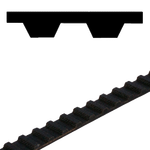Search & Find
The right product
Categories
Timing belts
General Description
Timing-belt drives enable a quiet operation and synchronous transmission of power. As they are maintenance free, these drives are very cost efficient. Due to varying requirements and consideration of the latest developments, there are a large number of different profiles, belt types and pulleys on the market. When non-positive drives (e.g. v-belt systems) are replaced, it is worth considering whether a conversion to a positive power transmission could be allowed from a safety point of view (some drives require slip at overload).
Selection and Dimensioning
The belt material and type of timing belt must be selected considering the specific situation (e.g. required features regarding machine or surroundings). There are performance tables and a user-friendly calculation programme on the internet to help you select the correct size. Small pulley diameters reduce the service life. And at least 6 teeth should be engaged at any time. When consulting the performance tables, several application-specific operating factors must be considered.
Mounting and Maintenance
At least one pulley must be equipped with flanges. The axes must be parallel (deviation no more than +0.5°). The belt must not be overstretched during mounting. For mounting and adjustment of the ideal belt there have to be sufficient possibilities for adjustment incorporated into the system.
Belt Tension
Each belt needs a certain pre-tension, depending on the type of belt, pulley diameter, center distance and the tangential force to be transmitted. The overall sum of tensioning and peripheral force must not exceed the permitted tensile force of the belt. The belt tension is best adjusted by altering the center distance. Otherwise a smooth tensioning pulley mounted on the outside or a toothed one on the inside of the belt may be used for adjustment.
Degree of degree of efficiency de
Depending on the type of belt (flexibility) and the number of teeth on the pulley (bending) the degree of efficiency can reach 98 %. Belts with tensile members of glass fibre cords (HTD and Inch) are particularly flexible.
Zoek & vind
The right product




